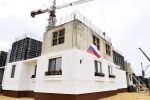Fitch Upgrades Metrofinanciera's IDRs to 'B-'; Outlook Stable
OREANDA-NEWS. Fitch Ratings has upgraded Metrofinanciera S.A.P.I. de C.V. Sofom, E.R.'s (Metrofinanciera) foreign and local currency long-term Issuer Default Ratings (IDRs) to 'B-' from 'CCC' and short-term IDR to 'B' from 'C'. Fitch has also upgraded Metrofinanciera's long-term and short-term national scale ratings to 'B-(mex)' and 'B(mex)', respectively, from 'CCC(mex)' and 'C(mex)'. A full list of rating actions follows at the end of this press release.
The upgrade of Metrofinanciera's IDRs and national scale ratings is driven by the positive trends in performance and cash flow generation which drove the faster-than-expected recovery in its financial results, as it posted fewer losses than anticipated in 2015 and expects to reach its break-even point and register moderate profits towards the end of 2016. Additionally, the upgrade considers the company's proven ability to grow its commercial loan portfolio and gradually rebuild its competitive position.
KEY RATING DRIVERS
IDRS and NATIONAL RATINGS
Metrofinanciera's IDRs and national ratings reflect its improved capitalization metrics and financial flexibility following the debt restructuring process that took place at the end of 2014. At that time, the company's debt certificates and certain development bank liabilities were swapped for equity shares.
As a result, its tangible common equity ratio increased to 19% in 2014 from 4.3% in 2013 (this ratio was 14.9% in 2015). The company's Fitch Core Capital Ratio (FCC) and regulatory capital ratio were 13.4% and 16.5%, respectively, as of December 2015 (2014: 16.6% and 24.4%). Fitch considers that despite this improvement, Metrofinanciera's loss absorption capacity continues to be pressured by the high level of unproductive assets on its balance sheet. The entity expects to maintain a capital-to-assets ratio of around 17% in 2016 and 15.4% in 2017.
Metrofinanciera's performance has been negative since the 2008 fiscal crisis; however, there are signs of recovery, since it posted fewer losses than expected in 2015. Additionally, the company forecasts it will reach its break-even point and register moderate profits towards the end of 2016, sooner than it had initially forecast according to its plan. Its efficiency ratio stood at 68.8% in 2015, as the company registered pre-impairment operating profit for the first time since 2008. Its operating return on assets (ROA) was negative 1.6% in 2015, compared with negative 19% in 2014.
Fitch expects that the company will be able to sustain the incipient recovery in financial performance by benefitting from the low interest expenses continuing since the last debt restructuring process and as its growing commercial loan portfolio provides an increasing income base, while it keeps operating costs contained and continues disposing of its unproductive assets.
Since the 2014 restructuring, all of Metrofinanciera's funding is provided by Sociedad Hipotecaria Fedederal (SHF; a local development bank), which became the majority shareholder in 2014, and Fondo de Operacion y Financiamiento Bancario a la Vivienda (Fovi; a trust administered by SHF). The maturity profile of the credit lines is manageable, with only MXN17.4 million due in 2016, which is amply covered by existing liquidity in the form of cash equivalents (4.4x as of December 2015). The company benefitted from the post-restructuring terms, as it was determined that payment of the credit lines would be made using a pass-through scheme by making payments as collections on the loan portfolio were made.
Metrofinanciera became a regulated financial entity in 2015. During the past year the entity implemented important improvements in corporate governance practices, internal controls, and risk management, which Fitch deems as positive for the long-term prospects of the entity, given that events in 2008 were partially related to poor control over internal processes.
Asset quality continues to be one of Metrofinanciera's main weaknesses, in terms of non-performing loans (NPLs), foreclosed real estate, and other unproductive assets. As of December 2015, the company's impaired loan ratio stood at 24.9%, down from the 36.6% in 2014. Reserves covered 67.1% of impaired loans as of December 2015 (2012-2014 average: 64.5%).
As of December 2015, the company had foreclosed assets amounting to MXN590 million. The impaired loan ratio adjusted for gross charge-offs and foreclosed real estate was a high 35.4% in 2015 (2014: 47.4%).
RATING SENSITIVITIES
IDRS and NATIONAL RATINGS
Rating upside potential is limited in the short- to medium-term. Fitch will consider upgrading Metrofinanciera's ratings when the company proves it is able to consolidate the recovery of its financial performance in the medium term and sustain positive cash flow, while it continues to grow its commercial loan portfolio and maintains related loan impairment charges at adequate levels. Further improvements on asset quality (NPLs and portfolio concentrations) could also benefit the ratings.
Ratings could be downgraded if the company is not able to sustain the recent recovery in its financial performance. A material deterioration of its commercial loan portfolio and pressures on its capital position reflected in an FCC below 10%, along with failure to generate positive cash flows could also negatively affect Metrofinanciera's ratings.
Fitch upgrades the following ratings:
Metrofinanciera S.A.P.I. de C.V. Sofom, E.R.
--Long-term foreign currency IDR to 'B-' from 'CCC';
--Short-term foreign currency IDR to 'B' from 'C';
--Long-term local currency IDR to 'B-' from 'CCC';
--Short-term local currency IDR to 'B' from 'C';
--National Long-term rating to 'B-(mex)' from 'CCC(mex)';
--National Short-term rating to 'B(mex)' from 'C(mex)';
The Rating Outlook is Stable.




Комментарии